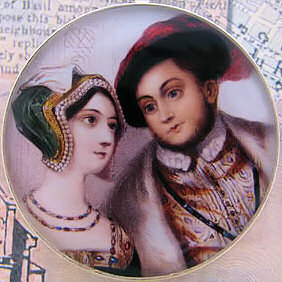 According to Archbishop Thomas Cranmer, King Henry VIII married Anne Boleyn on St Paul’s Day 1533, i.e. 25th January 1533, in a ceremony that was so secret that even Cranmer did not find out about it until several weeks after the happy event.
According to Archbishop Thomas Cranmer, King Henry VIII married Anne Boleyn on St Paul’s Day 1533, i.e. 25th January 1533, in a ceremony that was so secret that even Cranmer did not find out about it until several weeks after the happy event.
However, this may not have been the first secret marriage ceremony for the couple. Chronicler Edward Hall records:
“The kyng after his returne, maried priuily the lady Anne Bulleyn, on sainct Erkenwaldes daie, whiche mariage was kept so secrete, that very fewe knewe it, til she was greate with child, at Easter after.”
Hall is saying that the couple married on St Erkenwald’s Day, 14th November, on their return from Calais in 1532. We know that Henry and Anne landed at Dover, on the south coast of England, at 5 am on 14th November 1532 so it is possible that they got married or formally betrothed on that day. They certainly didn’t rush back to London, with the King spending a few days in Dover and the surrounding area “for the purpose of having harbours constructed in the said town, or at least of creating a spacious plea for asking money from his subjects for the said works” and not arriving back at Eltham Palace until 24th November.
It is impossible to know whether Edward Hall is correct – we don’t know where this information came from – but, as historian Eric Ives pointed out, it is at this point that the couple started co-habiting and therefore risking pregnancy, and Anne Boleyn appears to have been pregnant by the time they went through the marriage ceremony on 25th January 1533. As I said in a previous article, following the couple’s successful trip to Calais, With King Francis I pledging his support, “I think that Henry was confident that his ‘great matter’ would soon be resolved and so entered into some kind of betrothal or marriage with Anne. Once his marriage to Catherine had been annulled, this marriage would be the legal one.”
What do you think?
Also on this day in history…
- 1501 – Catherine of Aragon married Arthur, Prince of Wales, at St Paul’s Cathedral. Click here to read more.
- 1541 – An inventory was taken “of the goods and chattels, lands and fees of Thos. Culpeper, the younger”, the alleged lover of Queen Catherine Howard. Click here to read more.
Notes and Sources
- Ed. Cox, Rev. John Edmund (1844) Miscellaneous writings and letters of Thomas Cranmer, edited for the Parker Society, Cambridge University Press, p.246.
- Hall, Edward (1809) Hall’s chronicle: containing the history of England, during the reign of Henry the Fourth, and the succeeding monarchs, to the end of the reign of Henry the Eighth, in which are particularly described the manners and customs of those periods. Carefully collated with the editions of 1548 and 1550, printed for J. Johnson; F.C. and J. Rivington; T. Payne; Wilkie and Robinson; Longman, Hurst, Rees and Orme; Cadell and Davies; and J. Mawman; London, p.794.
- Calendar of State Papers, Spain, 1531-1533, p.556-557.